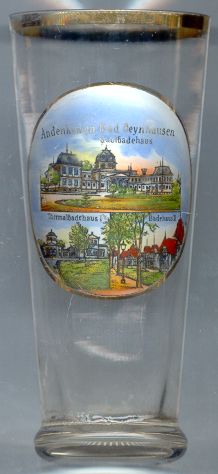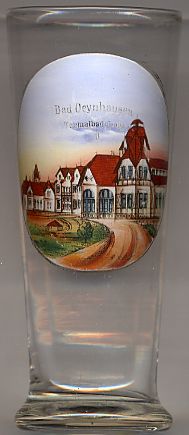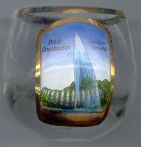

|
| DEUTSCHLAND | GERMANY |
| Bundesland: Nordrhein-Westfalen | North Rhine-Westphalia |
| Regierungsbezirk: Detmold | |
| Kreis: Minden-Lübbecke |
Bad Oeynhausen is situated at an elevation of 79 m at the rivers Werre and Weser in northeastern Northrhine-Westfalia. Its history goes back to the first saline springs that were discovered here in 1745 and became the basis for salt produktion. When the saline was also used for therapeutic purposes, the original name of the saline, Neusalzwerk, also became the name of the first modest spa. Beginning in 1830, deep wells were drilled in order to increase the productivity of the saline works. However, after 15 years of futile attempts of finding rock salt, as had been hoped, thermal saline springs were discovered. It was the idea of the chief engineer, Carl Freiherr von Oeynhausen, to use the saline for the spa. In 1848, King Friedrich Wilhelm IV of Prussia decided to rename the spa Bad Oeynhausen. When the rural community around the spa beacme chartered as a town in 1860, the new town took the name of the spa. Bad Oeynhausen soon became one of the most popular spas of Europe. The new spa park was laid out by the most famous garden architect of that time, Joseph Lenné, and many impressive mansions were built. After World War II, Bad Oeynhausen became the seat of the British Rhine Army and it took until 1954 that the spa could operate again.


The pictures on glass no. 1752 [left] show three historic bath houses:
The  Solbadehaus
Solbadehaus
The  Thermalbadehaus
Thermalbadehaus
The  Badehaus II
Badehaus II

The  Jordan-Sprudel [near left, no. 1430] was discovered in 1926 at a depth of 725 m.
The thermal waters (36°C) contain high concentrations (2.5%) of sodium, chloride and sulfate. The well supplies about
6,000–7,000 litres of water per minute. Carbon dioxide liberated from the water while it wells up naturally forces the waters 40–50 m above the ground.
The spring was named for spa director Albert Jordan (1865–1934).
Jordan-Sprudel [near left, no. 1430] was discovered in 1926 at a depth of 725 m.
The thermal waters (36°C) contain high concentrations (2.5%) of sodium, chloride and sulfate. The well supplies about
6,000–7,000 litres of water per minute. Carbon dioxide liberated from the water while it wells up naturally forces the waters 40–50 m above the ground.
The spring was named for spa director Albert Jordan (1865–1934).
![[scale]](lineal.jpg)